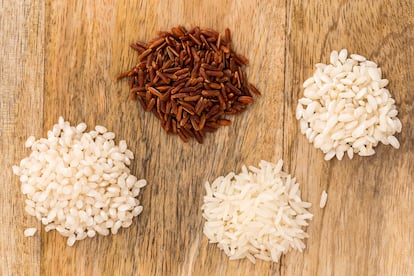Arsenic in food: Should you wash your rice before cooking?
The European Food Safety Authority has updated its assessment of dietary exposure to arsenic, as new evidence suggests it may increase cancer risks

“Consumer exposure to inorganic arsenic in food raises a health concern,” states the updated risk assessment published in late January by the European Food Safety Authority (EFSA). This confirms the concerns of those who wash their rice before cooking and throw away the leftover water due to fears about arsenic. Before jumping to conclusions, let’s see if such measures are necessary.
First, let’s clarify that no food alert has been issued, which only happens when contaminants pose an immediate health risk to consumers. The EFSA conducts periodic risk assessments to evaluate the current state of specific foods, taking into account new scientific knowledge and consumer habits. After its assessment, appropriate measures are implemented to protect consumer health, if needed.
Why is there arsenic in food?
Arsenic is a naturally occurring element found in the Earth’s crust. It is widely distributed in the environment through natural sources like volcanic emissions, forest fires and the erosion of minerals and rocks. Human activities like mining, metallurgical industry emissions, and the use of insecticides and herbicides also disseminate arsenic.
This means that many foods can be contaminated with arsenic and its compounds, although some cases are more concerning than others. For instance, fish commonly contain organic forms of arsenic like arsenobetaine, which are less worrisome compared to inorganic forms that are highly toxic. That’s why the latest EFSA report focuses on evaluating the latter. Rice, grains and derivative food products are the primary sources of human exposure to arsenic. It’s also worth noting that arsenic can be found in drinking water.
What are the health effects of arsenic?
Inorganic arsenic, known as a potent poison throughout history and used as a pesticide, is found in smaller amounts in contaminated water and food. This can increase the risk of various cancers, including skin, bladder, lung, kidney, liver and prostate cancer. It can also lead to skin lesions, neurotoxicity, cardiovascular disease, abnormal glucose metabolism and diabetes, among other adverse effects.

Arsenic is a compound that can be harmful to health as it is both genotoxic (a property of chemical agents that damage the genetic information within a cell, causing mutations) and carcinogenic. Any amount of arsenic can potentially pose a danger. The severity of the effects depends on the dose and level of exposure. To illustrate, we can compare it to tobacco smoke, which contains genotoxic compounds. Even a small amount of tobacco smoke can lead to adverse effects like lung cancer. However, the likelihood of developing the disease increases with greater exposure and higher doses of smoke.
What foods should we avoid?
Water, rice, grains and derivative food products contribute the most to dietary exposure to arsenic. However, this doesn’t mean we should avoid consuming them or take extreme measures at home. The EFSA report focuses on assessing the risk of arsenic consumption and doesn’t recommend any extreme measures. Spain’s Agency for Food Safety and Nutrition (AESAN) supports this view as follows:
- Grains are a vital source of complex carbohydrates that, when combined with other foods, have a positive impact on health. To ensure a healthy diet, it is recommended to consume three to six daily servings of grains (such as wheat, corn, rice, oats, etc.), preferably whole grains, depending on energy requirements.
- Water is the preferred beverage for a healthy diet, and the arsenic levels in water are generally minimal.
- Avoid eating hijiki seaweed because it contains high levels of inorganic arsenic.
To wash or not to wash
To address concerns about arsenic in food, let’s clarify some important details:
- Not all rice has the same amount of arsenic. Generally, brown rice has higher levels than conventional rice (about 1.7 times more) due to the way it accumulates in the grain.
- The source of rice also plays a role. For instance, countries like India and Bangladesh have higher levels of inorganic arsenic in rice, primarily due to contamination of irrigation water. However, all rice sold in the European Union must adhere to the maximum limits set by European legislation, regardless of where it comes from.
- To reduce exposure to arsenic, it’s recommended to follow a varied diet by consuming different types of grains. Consuming rice every day, especially whole grain rice, may not be ideal, particularly for certain population groups like young children or people with gluten-related disorders. Instead, seek more variety and include other suitable grains like corn in your diet, while limiting the consumption of rice-based products such as beverages, pasta and pancakes.
Thoroughly washing the rice (rinsing six times) before cooking can remove between 10% and 30% of the arsenic. Cooking the rice with plenty of water (1:6 ratio) and discarding the leftover water can remove around 30-45% of the arsenic. However, the effectiveness of these methods may vary depending on the rice variety. Some studies suggest up to 57% of the arsenic is eliminated, while other studies like the one cited by AESAN indicate only 11% is eliminated. Washing rice may also eliminate some of the nutrient content of rice.
Are we being exposed to dangerous amounts of arsenic?
To assess the safety of arsenic, EFSA evaluated the risk of skin cancer, which is a significant concern. This conservative approach also covers the other adverse effects associated with this contaminant. This is reference point is also more conservative than its last risk assessment in 2009. EFSA concluded that dietary exposure to arsenic is a cause for concern for average and heavy consumers of rice. For instance, someone who eats rice daily may have a 5% (or higher) increased risk of developing skin cancer compared to those who eat less rice.
In younger age groups, especially children up to 10 years old, exposure levels to arsenic are higher due to their lower body weight. However, EFSA says this does not necessarily mean that they are at a higher risk. The adverse effects of arsenic are typically a result of long-term exposure, and most epidemiological studies focus on adults who would have had much longer dietary exposures.
What food safety measures are being taken?
In the agri-food industry, various measures have been implemented for years to minimize arsenic levels. For instance, irrigation water undergoes regular testing and controls.
We also test drinking water and certain foods to ensure they meet the maximum arsenic limits set by regulations.
Based on the new EFSA report, it is likely that additional food safety measures will be taken in the coming months to limit public exposure to organic arsenic and total arsenic. This may include stricter controls on certain foods or providing consumption recommendations for vulnerable groups.
Sign up for our weekly newsletter to get more English-language news coverage from EL PAÍS USA Edition
Tu suscripción se está usando en otro dispositivo
¿Quieres añadir otro usuario a tu suscripción?
Si continúas leyendo en este dispositivo, no se podrá leer en el otro.
FlechaTu suscripción se está usando en otro dispositivo y solo puedes acceder a EL PAÍS desde un dispositivo a la vez.
Si quieres compartir tu cuenta, cambia tu suscripción a la modalidad Premium, así podrás añadir otro usuario. Cada uno accederá con su propia cuenta de email, lo que os permitirá personalizar vuestra experiencia en EL PAÍS.
¿Tienes una suscripción de empresa? Accede aquí para contratar más cuentas.
En el caso de no saber quién está usando tu cuenta, te recomendamos cambiar tu contraseña aquí.
Si decides continuar compartiendo tu cuenta, este mensaje se mostrará en tu dispositivo y en el de la otra persona que está usando tu cuenta de forma indefinida, afectando a tu experiencia de lectura. Puedes consultar aquí los términos y condiciones de la suscripción digital.
More information
Archived In
Últimas noticias
Most viewed
- Alain Aspect, Nobel laureate in physics: ‘Einstein was so smart that he would have had to recognize quantum entanglement’
- Alvin Hellerstein, a 92-year-old judge appointed by Bill Clinton, to preside over Maduro’s trial in New York
- Gilles Lipovetsky: ‘If you want to live better and fall in love, take Prozac, don’t look to philosophy’
- Cuba confirms death of 32 of its citizens in the US attack against Venezuela
- Why oil has been at the center of Venezuela-US conflicts for decades











































